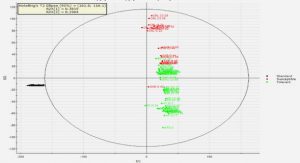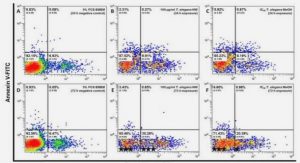Get Complete Project Material File(s) Now! »
Mathematical modeling of start-up scenarios for nitrogen removal via a nitritation: anaerobic ammonium oxidationcoupled biofilm in a hollow fiber membrane bioreactor Romeo E. Capuno, Jr.1 , Nancy G. Love1,2 and Barth F. Smets3
1Department of Civil and Environmental Engineering and 2Department of Biological Sciences, Virginia Tech, 418 Durham Hall (0246), Blacksburg, VA 24061, E-mail: recapuno@vt.edu, nlove@vt.edu; 3 Institute of Environment and Resources, Technical University of Denmark, DK-2800 Lyngby, Denmark, E-mail: bfs@er.dtu.dk
Abstract A mathematical model of a nitritation: anaerobic ammonia oxidation-coupled biofilm in a hollow fiber membrane bioreactor (HFMBR) was developed and implemented using AQUASIM. Four processes were considered, including aerobic ammonia oxidation, nitrite oxidation, anaerobic ammonia oxidation (anammox) and heterotrophic denitrification. Stoichiometric coefficients were derived from the equation consisting of cell synthesis, electron donor and electron acceptor half reactions. Four different start-up scenarios were investigated. Two scenarios examined the reactor performance when the supply of nitrite was dependent solely upon nitritation while the other two scenarios investigated the reactor performance when nitrite was supplemented in the feed. In each of the scenarios, total nitrogen removal and biomass and soluble component concentration profiles within the biofilm were determined over a 500-day period. Modeling results revealed that nitrite supplementation in the feed facilitated start up of HFMBR by providing nitrite to anaerobic ammonia oxidizing bacteria (AnAOB). Results also showed that oxygen flux affects the reactor performance by improving nitrogen removal and reducing the start-up time. Nitrogen removal with nitrite supplementation was found to be higher by approximately 40% than with the system depending solely upon nitritation. At some JO2/JNH4+, determining the optimum JO2/JNH4+ is expected to improve the nitrogen removal under latter scenario.
Keywords: biofilm modeling, counter-diffusion biofilm, anaerobic ammonia oxidation, hollow fiber membrane bioreactor, multi-species, oxygen-limited condition
Introduction
In a typical wastewater treatment plant, high nitrogen-containing (~100 to ~1,000 mg/L) waste streams from anaerobic stabilization and dewatering processes are typically recycled back to the liquid process treatment system. If the waste stream is not treated prior to recycling, the liquid treatment stream must accommodate a higher ammonia load through the biological treatment process. In selected cases, plant capacity is insufficient to address this added load and continue to meet effluent guidelines for N. Treating this waste stream prior to reintroducing it to the liquid train offers an opportunity for cost effective treatment strategies that could reduce the mass of nitrogen discharged by the plant. Technologies to treat these ammonia-concentrated waste streams may also be applied to other high ammonia wastes, such as those generated by planetary base stations and the international space station. Novel nitrogen removal processes may be advantageous in these applications. Anaerobic ammonia oxidation (anammox) utilizes ammonia as electron donor and nitrite as electron acceptor under anaerobic conditions (Strous et al. 1999b; Strous et al. 1998b). Several researchers have investigated different reactor configurations for achieving strictly anammox growth, and nitritation: anammox-coupled growth. Configurations for strictly anammox growth include sequencing batch reactors (Dapena-Mora et al. 2004; Kuai and Verstraete 1998; Nielsen et al. 2004; Sliekers et al. 2002; Strous et al. 1998b; Third et al. 2005b; Wett et al. 1998), fluidized bed systems (Strous et al. 1997a), completely stirred tank reactors (Guven et al. 2004), fixed-film bioreactors (Pynaert et al. 2004; Strous 1997) and anaerobic biological filtrated reactors (Isaka et al. 2005). On the other hand, configurations for nitritation: anammox-coupled growth include sequencing batch reactors (Dapena-Mora et al. 2004; Kuai and Verstraete 1998; Nielsen et al. 2004; Sliekers et al.2002; Strous et al. 1998b; Third et al. 2005b; Wett et al. 1998) and rotating biological reactors (Pynaert et al. 2004; Windey et al. 2005). In a nitritation: anammox coupled system, nitritation provides the required nitrite to anaerobic ammonia oxidizing bacteria (AnAOB). The benefits of nitritation coupled with anammox when compared to conventional N removal treatment are: lower oxygen demand; lower alkalinity consumption; no exogenous electron donor requirement; and lower biomass production. Several strategies have been proposed to attain stable nitrite accumulation in these systems,such as pH control, temperature control and dissolved oxygen control (Bernet et al. 2005). Since nitrite-oxidizing bacteria (NOB) are more sensitive to free ammonia than aerobic ammonia oxidizing bacteria (AOB), NOBs will be inhibited at higher pHs. Temperature can also be used to control nitritation. At temperatures higher than 25oC, AOBs have a higher growth rate than NOBs; thus, they can outcompete NOBs. Aside from pH and temperature, nitritation can also be controlled by the amount of dissolved oxygen present in the system. At low dissolved oxygen concentrations, aerobic ammonia oxidation will be favored since NOBs have a lower affinity to oxygen.
I. LITERATURE REVIEW
A. INTRODUCTION
B. CONVENTIONAL NITROGEN REMOVAL: NITRIFICATION-DENITRIFICATION
C. ALTERNATIVE NOVEL BIOLOGICAL NITROGEN REMOVAL TECHNOLOGIES
C.1. Nitritation-Denitritation
C.2. Anaerobic ammonia oxidation
C.3. Combined nitritation-anaerobic ammonia oxidation
C.4. Oxygen limited novel nitrogen removal processes
C.5. Sulfide driven conversion-anammox coupled process
C.6. Comparison of the different nitrogen removal processes
C.7. Mathematical modeling of the oxygen-limited nitrogen removal process
D. SCOPE OF RESEARCH
E. REFERENCES
II. MATHEMATICAL MODELING OF START-UP SCENARIOS FOR NITROGEN REMOVAL VIA A NITRITATION: ANAEROBIC AMMONIUM OXIDATION-COUPLED BIOFILM IN A HOLLOW FIBER MEMBRANE BIOREACTOR
A. INTRODUCTION
B. MODEL AND SIMULATION
B.1. Biofilm model
B.2. Model development
B.3. Model assumptions and kinetic parameters
C. RESULTS AND DISCUSSION
C.1. Derivation of stoichiometric coefficients
C.2. Development of aerobic and anaerobic zones within the biofilm
C.3. Nitrogen removal with and without nitrite supplementation
C.4. Effect of membrane air pressure on nitrogen removal
C.5. Effect of increasing ammonia in the feed to the scenarios without nitrite supplementation
D. CONCLUSIONS
E. REFERENCES
III. MATHEMATICAL MODELING OF DIFFERENT SCENARIOS FOR NITROGEN REMOVAL VIA A NITRITATION: ANAEROBIC AMMONIUM OXIDATION-COUPLED PROCESS IN A ROTATING BIOLOGICAL CONTACTOR
A. INTRODUCTION
B. MODEL AND SIMULATION
B.1. Model description
B.2. Model assumptions
B.3. Model simulations
C. MODEL RESULTS AND DISCUSSION
Effects of different process options on the reactor performance under the same loading conditions
C.1. Number of reactors
C.2. Initial AnAOB fraction
C.3. Bulk oxygen concentration
C.4. Biofilm thickness
D. CONCLUSION
E. REFERENCES:
IV. SIGNIFICANCE OF THE RESEARCH
APPENDIX A
APPENDIX B
APPENDIX C






